October 21, 1966 marked a major event in the history of Baylor University when students, trustees, faculty and supporters gathered to celebrate the groundbreaking of a “modern, functional and beautiful” new library. Named in honor of a generous gift from the Moody Foundation of Galveston, the Moody Memorial Library building was a much-needed expansion of Baylor’s physical plant and a crucial element in a long-range plan called Projection 68 that sought to grow the university’s physical footprint and enhance its reputation as an institution of higher education.
A Key Component of Projection 68
A new library facility was identified as one of three major components of Projection 68, an ambitious plan aimed at rejuvenating the aging infrastructure of Baylor’s campus. Parts of the campus built environment dated to the mid 1880s with buildings like Old Main and Burleson Hall, and the library facilities housed in the Carroll Library building were woefully inadequate for the swelling numbers of students enrolled in classes by the 1960s.
Tom Parrish, director of development and a participant in the Moody ceremony, called Projection 68 “a plan which when realized ‘will raise Baylor to a new plateau of service. We must think big and act big because the challenge is big at Baylor.'” In addition to the new library, Projection 68 called for construction of a new wing on Waco Hall for the School of Music; improvements to the auditorium at Waco Hall; and construction of a new science building.
Moody Memorial Library was slated for construction at the far end of what is known today as Fountain Mall, just across Third Street from the main campus. In 1966, the land across Third Street from campus was residential all the way to the Brazos River. This aerial photo by Windy Drum, from The Texas Collection Photographic Archive, shows the general area in the mid-1950s.
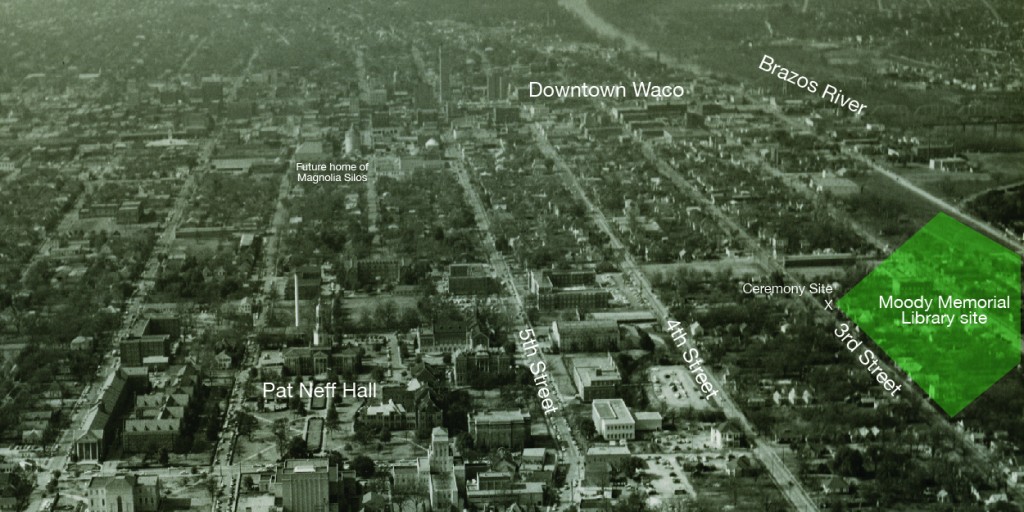
As part of a major redevelopment project called Urban Renewal – which radically transformed the landscape of Waco during the 1960s – the area between Third Street and the Brazos River was acquired and ceded to the university by the Baylor-Waco Foundation, and plans to expand campus toward the river began immediately.
A call for proposals for the library’s new design went out and the winning bid went to the Dallas architecture firm of Jarvis Putty Jarvis. An early rendering of the library – proposed to be situated on Burleson Quadrangle, not the area across Third Street where it would eventually be built — looked like this:
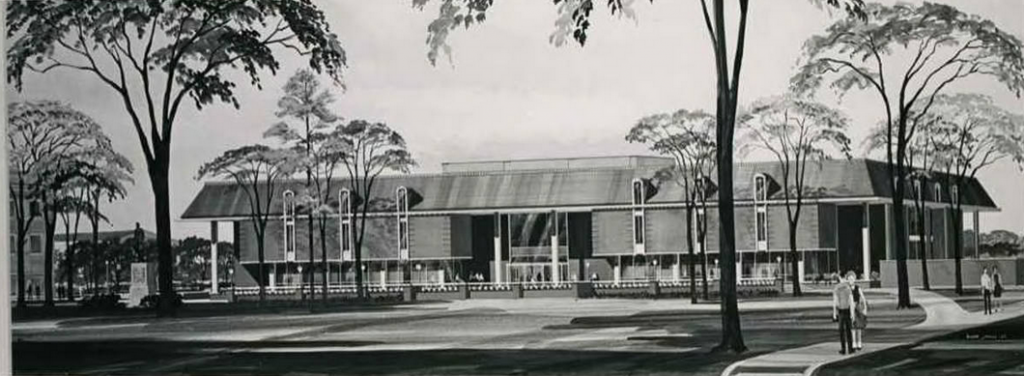
Moving the library’s site to the new area across Third Street also allowed for changes to be made to the proposed elevation of the facility, and the more-or-less final design was available for presentation by Jarvis Putty Jarvis at a meeting on October 14, 1966.

The same rendering can be seen in this photo of Joe Allbritton and Abner V. McCall from around the same time.

Images of the Ceremony
The day of the ceremony dawned clear but breezy. As Baylor Lariat reporter Mike McKinney noted in his front-page coverage of the event, “Speakers held down their notes, women covered their blowing hair and most everyone had on sunglasses” during the festivities.
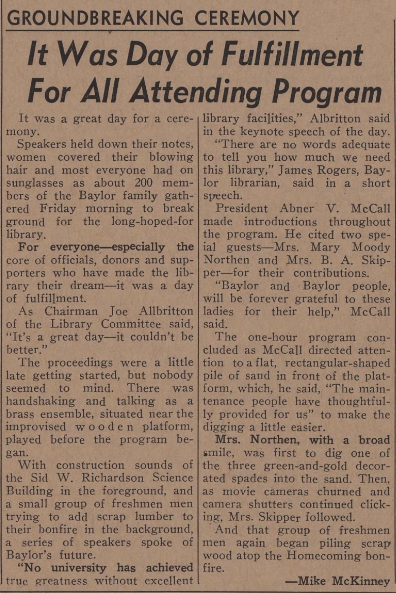
Dignitaries took their places on the viewing stand for a program that included speeches from Joe Allbritton (chair of the Board of Trustees’ Library Committee), Baylor University librarian James Rogers and Baylor president Abner V. McCall. A brass ensemble provided musical accompaniment to the festivities, and the event concluded with the ceremonial first shovelful of dirt being turned by Mrs. Mary Moody Northen of the Moody family. To make things easier for all involved, McKinney notes that a pile of sand was trucked in for the ceremony by maintenance crews so as to “make digging a little easier.”
We also know that no university has achieved true greatness without excellent library facilities.”
– Joe Allbritton, from groundbreaking ceremony address
Scenes from the ceremony were captured by commercial photography Lavern “Windy” Drum. The originals are available as part of the photographic holdings of The Texas Collection, with digital surrogates viewable in the Baylor University Libraries Digital Collections. Selections of those digital versions are presented here.

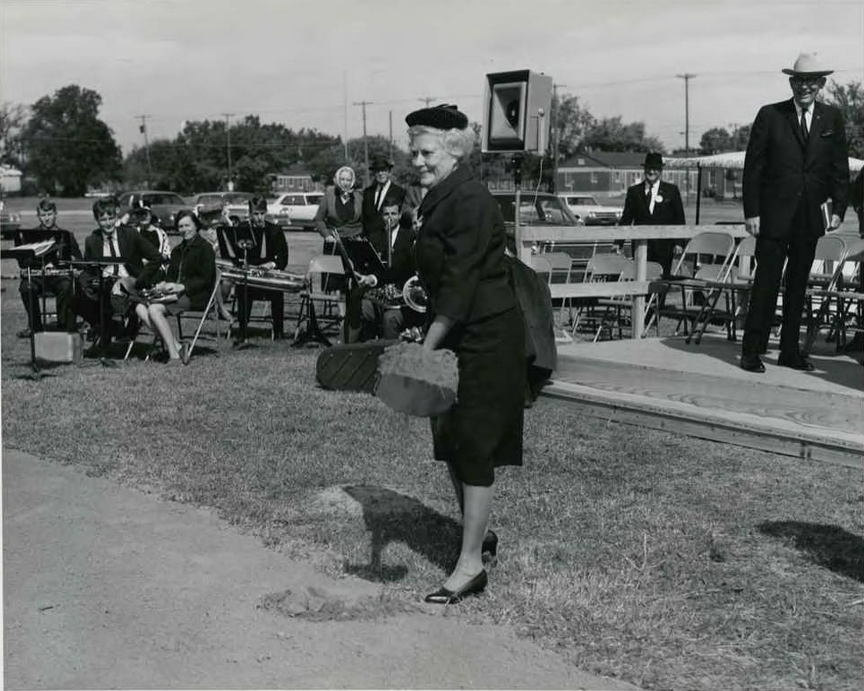
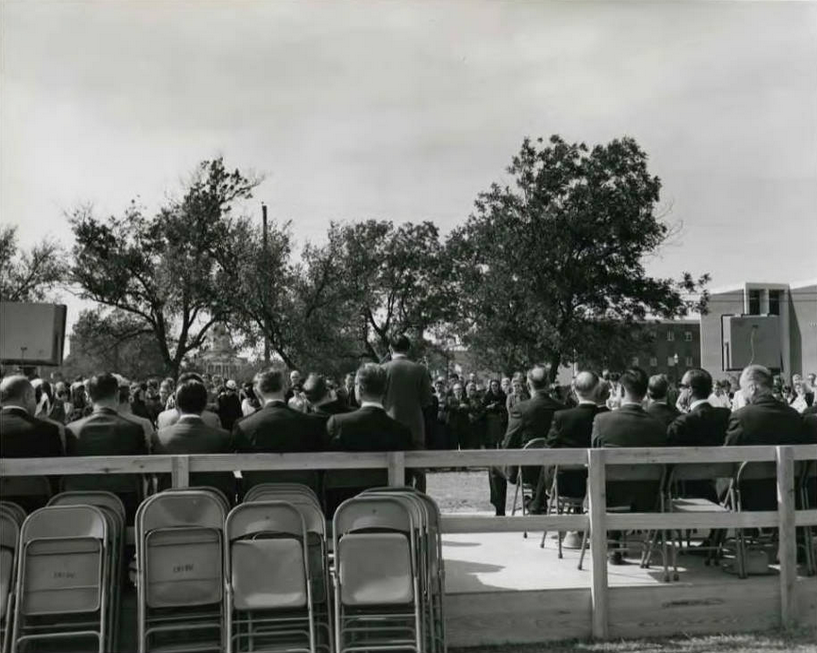

The speech delivered by committee chair Joe Allbritton was released as a press release after the ceremony, but it is reproduced here in non-ALL CAPS FORMAT for your review. Note that several sections of it are quoted directly in the coverage provided by the October 22 edition of the Baylor Lariat.
Text of Baylor trustees’ library committee chair Joe Allbritton’s speech at the Moody Memorial Library groundbreaking ceremony, Friday, October 21, 1966
There have been many momentous occasions in the 121-year history of Baylor University, but none excels the cause that brings us together this morning and none will mean more to the future greatness of our university.
I’m sure there are those who will disagree with that conclusion. Some may even contend that the winning of the Southwest Conference football championship in 1924 was a more auspicious achievement.
Suffice it to say we have somehow managed to survive on the gridiron for 42 years without another conference title and likewise we have progressed and grown into a respected and reputable institution of higher learning despite inadequate library facilities for at least that long a span of time.
I think it is reasonable, and certainly delectable, as we return to campus for homecoming, to speculate on the possibility of achieving both goals this year.
Of course, football fortunes come and go because they largely depend on the transitory nature of human elements — or translated into the Bridgers’ vernacular, manpower or personnel. School presidents, professors, even chairmen of library building committees are of but fleeting importance in the long-range scheme of building a great university.
But a library, and the wisdom and knowledge contained therein, is of a different nature.
Thomas Carlyle put it appropriately some 100 years ago when he said: “After all manner of professors have done their best for us, the place we are to get knowledge is in books. The true university of these days is a collection of books.” If true then, all the more is it true today. The explosion of knowledge since World War II, particularly in the physical sciences, makes it imperative that this relatively new knowledge be made readily accessible to the university student.
And certainly just as important as the new, mushrooming technology of the space age, are the truths, the opinions, and the philosophies of old — some of which, when brought into perspective can be of invaluable assistance in solving the social problems that still defy solution.
Norman Cousins, editor of the Saturday Review, addressed himself to this phase of a library’s importance when he wrote: “… one of the unhappy characteristics of modern man is that he lives in a state of historical disconnection. He has not put his experience to work in coping with new dangers. He has tended to segregate himself from the wisdom so slowly and painfully built up over long centuries. He has made the mistake of thinking that because there is so much that is new in the nature of contemporary crisis the past has nothing of value to say to use …”
“it is in this sense,” Cousins continued, “that the library may be able to speak to the human condition in today’s world. For books serve as the natural bloodstream of human experience. They make it possible for the big thoughts of big minds to circulate in the body of history. They represent a point of contact between the past and future.”
As we break ground today for the magnificent Moody Memorial Library I feel that we are commencing a new era of academic achievement and excellence at Baylor University. Today marks the beginning of the end of Projection 68 which was designed in 1963 to provide the physical improvements so necessary to further the academic maturation of our University.
Already completed are the improvements to our School of Music and the Auditorium in Waco Hall, and the new science building is well under way.
We have known for years that the inadequacy of physical facilities stood as a barrier to our objectives and that the lack of a modern, efficient, and excellent library was the major obstacle in the path toward a truly great university.
Through the dedication and hard work of many — the administration, the trustees, the ex-students, and the many friends of Baylor — we have been successful in raising most of the funds necessary to bring Projection 68 into reality.
While we must continue our efforts to assure our fundraising goals, we can now at least begin to shift our major development emphasis from the physical to the academic. While our physical plan needs were critical, we all realize that architecture, brick, and stone merely provide the proper setting and environment for those who work in the academic community and allow them to perform their tasks and services at a higher level of inspiration and efficiency.
We also know that no university has achieved true greatness without excellent library facilities.
Paul Buck, the former director of libraries at Harvard University, has pointed out that the quality of a university’s library is “a major factor in determining the quality of the education that an institution can provide and the quality of the faculty it can recruit. Strong libraries are essential to the full exploitation of intellectual resources and to the maintenance of free access to ideas,” he concludes.
In the past few years Baylor has reached the crossroads of excellence in education. The university administrators and trustees could have taken the path of least resistance — we could have patched the roof and taken other temporary measures and in so doing still maintained and improved a good university.
Rather, we took the more difficult path toward excellence, because it is the most logical road for Baylor to travel toward maintaining and improving and excellence undergraduate program and expanding the graduate program to meet the increasing demands of our state and nation.
So today, Baylor University, the oldest university in continuous service in the State of Texas, looks to the future with confidence and great expectations.
Our goal is not bigness, for this is not the function of a private, religiously oriented university. Rather, our objective is quality.
We have made great strides toward this objective. But always, the lack of physical facilities — particularly inadequate library space — has caused concern and slowed the pace of progress.
The modern, functional and beautiful Moody Memorial Library will be the catalyst that will move the university toward realization of its true potential.
NOTE: The preceding text was edited slightly from the original to address typographical errors. Read the full address in its original typewritten form in the Baylor University Libraries Digital Collections.
A Final Look at Early Moody
The 1967 Baylor Round Up, the campus yearbook, shows how much progress was made by the time the official story of 1966 had been documented and told by Baylor’s student journalists.
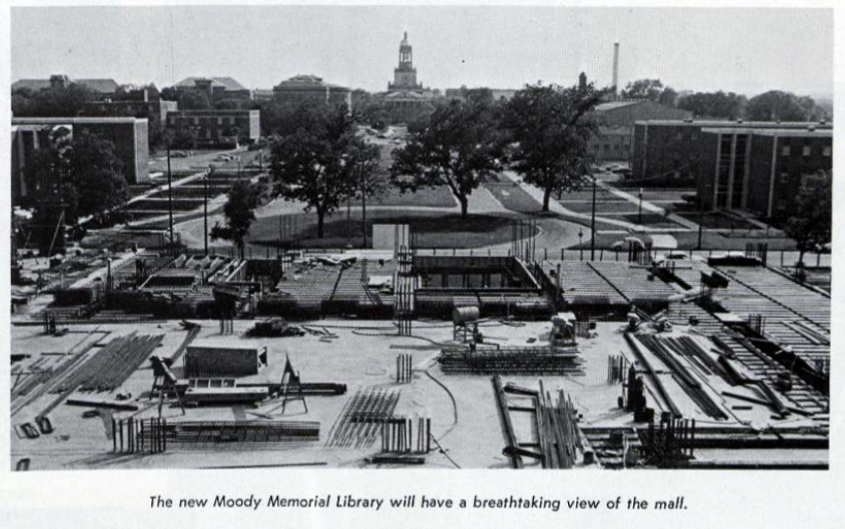
Today, we mark the 50th anniversary of the beginning of the building in which so many Baylor library staff, faculty and students have spent time – including those of us in the Digital Projects Group, whose offices are located on Moody’s Garden Level. We will be providing periodic updates to the construction and grand opening of Moody in advance of the 50th anniversary of its debut in 1968, so stay tuned to this blog for much more to come!